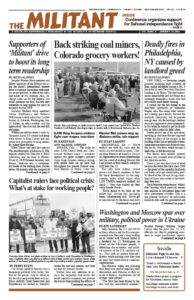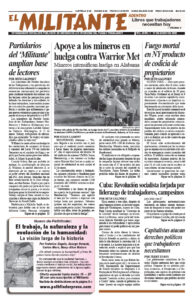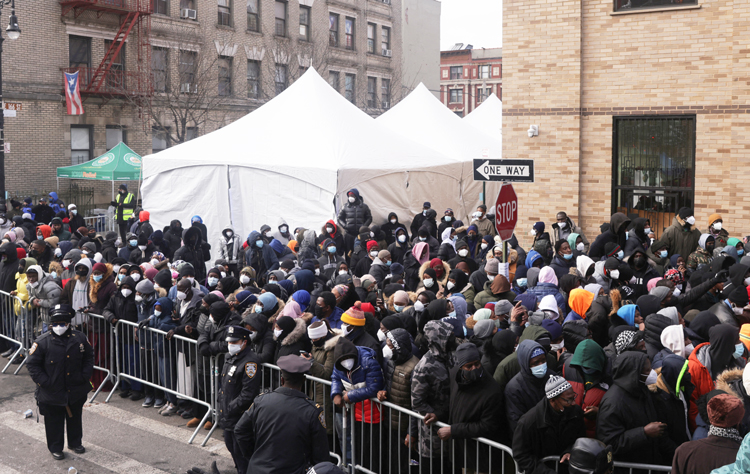NEW YORK — Seventeen people perished, including eight children, all from smoke inhalation during a Jan. 9 fire in the 19-story Twin Parks Northeast building in the Bronx. The big-business media immediately laid the blame on a seemingly thoughtless tenant who had left a faulty space heater running.
It turned out the fire started in the third-floor apartment of Mamadou Wague, who, like many other tenants, was running space heaters because the landlords chronically fail to provide enough heat. All the building’s hallway doors are supposed to close automatically, but when he rushed to get his family out, he didn’t notice his didn’t close.
Smoke poured out of the apartment, traveling up staircases that are supposed to take the place of fire escapes in the building, which has no sprinkler system. Some staircase doors also failed to close, like on the 15th floor, which became a death trap, as did the staircase.
Fire alarms were initially ignored, because they routinely went off when in fact there was no fire.
There is just one root cause of what became the worst fire here since 1990 — the greed of the capitalist landlords and banks who put maximizing profits ahead of the life and living conditions of those who reside in the buildings they own.
Twin Parks was earmarked as “affordable” housing, which meant its owners reap millions in low-interest loans and other government subsidies. This is a fast-growing “industry” for well-heeled landlords who seek the guaranteed and steady profits from these government programs — as long as they don’t run up too many expenses maintaining their properties.
Almost all of those who died were from families of immigrants from Gambia, most of them Muslims, although the residents of the building include Black as well as Latino families.
More than 1,000 people attended the Jan. 16 funeral for 15 of those killed, organized by Sheikh Musa Drammeh. “Let everybody see 15 caskets of their fellow Bronxites being buried because of the condition in which they lived,” he said at the Islamic Cultural Center, adding that if the building had adequate heat, there would never have been a fire in the first place.
History of neglect
This is not the first fire in the building. In 1986 smoke filled the building from a blaze in the compactor room. Luckily, no one was injured then.
On Jan. 11 several tenants filed a class-action suit against the management. Jessika Valdez, who is part of the suit, told the New York Post that the door to her 18th floor apartment has “never closed on its own” during the 15 years she’s lived there.
A team of Militant correspondents spoke with residents in the area. They were told that lack of heat is common in the Bronx neighborhood, along with numerous other maintenance problems. One tenant invited them into her apartment to show them a badly leaking ceiling the landlords have failed to repair.
“Affordable” housing is big business. And Twins Parks has been a source of big profits for the city’s landlords and banks for years.
A joint venture of three firms that specialize in taking advantage of government “affordable” housing programs bought the Bronx tower and seven other properties in 2019. They benefited from $36 million in loans from the New York State Housing Finance Agency. Federally financed Freddie Mac guaranteed the loans, lowering the interest rate. The U.S. Department of Housing and Urban Development’s Section 8 program pays the rent on 76 of the building’s 120 units, guaranteeing risk-free income.
Rick Gropper — a founder of Camber, one of the three firms — served as a “housing adviser” on newly elected Mayor Eric Adam’s transition team. Camber started out in 2016 with just one building. Now it owns 24 projects, many turning profits taking advantage of government programs.
Many real estate companies also take advantage of a special tax credit for “maintaining” units for low-income families. It’s not yet known if Camber and their landlord co-owners get those credits as well.
Not wanting to miss out on rent payments, the building owners are trying to get residents who were evacuated during the fire to come back to the 85 units still considered habitable, despite the smoke damage and remaining problems with the building.
Tenant Walter Williams told the New York Times that a building representative called him saying, “We could get you back in a few days,” as soon as they repaint and put on a new door. “I stepped on a human dead person” on my way out, Williams said, incredulously, “and they want me to go back.”
Nearby community centers have received an outpouring of donations for the fire victims, so much that some are asking people to stop bringing things by.
“This tragedy shows why working people can’t rely on the capitalist government for anything,” Socialist Workers Party spokesperson Willie Cotton told the Militant. “Under the guise of providing affordable housing, the government enriches the landlords and other capitalists. The capitalist system counts success in the profits reaped by a handful, not on human life.
“That’s why we need to fight for a government-funded public works program, under the control of workers and our unions, to build, fix and maintain the affordable, truly comfortable housing working people need and deserve.
“In the course of fighting to take political power into our own hands and create a government of workers and farmers, working people will forge powerful unions and mass neighborhood organizations,” Cotton said. “We will ensure everyone has housing and every building is safe, enforced by committees of tenants backed by their own revolutionary government.”
‘Disaster waiting to happen’ in Philadelphia public housing fire
PHILADELPHIA — In the deadliest home fire in a generation in Pennsylvania, 12 people were killed Jan. 5 in a public housing row-house apartment in the Fairmount neighborhood here. Several others were hospitalized with serious injuries. This catastrophe was the product of the disdain for working people shown by city officials and the Philadelphia Housing Authority.
The three floors of the home had no working smoke detectors, and no fire escape, sprinkler system or fire extinguishers. Twenty-six people in multigenerational families resided there. Twenty-two were home when the fire broke out.
The 12, all who died of smoke inhalation, had been trapped on the upper two floors. A 5-year-old child on the second floor who survived told authorities that he accidentally ignited their Christmas tree while playing with a lighter, starting the fire.
The deceased include three sisters — Rosalee McDonald, 33; Virginia Thomas, 30; Quinsha White, 18 — and nine of their children, ages 2 to 16. A mass public funeral was held Jan. 17 at Temple University’s Liacouras Center.
The night after the fire 100 people joined together outside the Bache-Martin Elementary School where some of the children had attended, paying tribute and wondering how this tragedy could have ever happened.
Disregard by housing authority
The row house has been owned since 1969 by the Philadelphia Housing Authority, Pennsylvania’s largest landlord. The PHA is funded by the federal government to provide housing for low-income residents. Kelvin Jeremiah, president and CEO of the Philadelphia Housing Authority, claimed modern smoke alarms with 10-year lithium-ion batteries had been installed in the building and inspected last year.
But Philadelphia Fire Commissioner Adam Thiel refuted that, saying all the alarms on the three floors were older models that used 9-volt batteries and none of them were working at the time of the fire. There was one new model in the basement, but it didn’t activate until it was too late.
Without a fire escape, and the stairs down to the first-floor doors blocked by fire and smoke, the residents suffocated to death. When asked at a press conference two days later why older housing authority buildings don’t have fire escapes, Jeremiah pointed to other homes in the middle-class Fairmount neighborhood and callously replied, “I’m not sure if I look around here I’ll be seeing [fire escapes] in any of these million-dollar homes.”
The city’s building code doesn’t mandate fire escapes in any city properties, or fire extinguishers, sprinklers, or tamper-proof smoke detectors in one- and two-unit structures. Philadelphia Housing Authority inspection records from last spring show still-pending maintenance requests for the now fire-gutted home, for broken light fixtures, an inoperable stove, deteriorating sheetrock walls and ceilings, and pest infestation.
One of the families’ grandmothers had signed her lease in 2011 for three daughters and one child. But as the family grew, they requested but were never offered a larger residence. The housing authority had “absolutely no indication” the family wanted to move, Jeremiah told the Philadelphia Tribune Jan. 8.
But Caleb Jones, a child therapist working with two of the children, denied that was true. “Rosalee [McDonald] believed it wasn’t safe,” Jones told the New York Times Jan. 8. He said that the “family had wanted to move to a larger home for years.” Jones said the “children were self-conscious about the house” and wouldn’t let friends come beyond the outside steps.
Fire victim Virginia Thomas had just recently messaged Facebook friends asking for a new place to stay. The night before the fire she contacted the grandmother of some of her children saying, “I’m trying to get out of here, to find a place for me and my kids.”
Firehouse closed in budget cuts
Eighty thousand people live in Philadelphia Housing Authority homes, with another 40,000 families on the waiting list. An estimated 206,000 households are eligible. But that list was cut off in 2013, except in cases of elderly or disabled residents. “Philadelphia is supplying less than 12% of the publicly supported housing needed for its low-income households,” wrote the Times.
The Fairmount building was one of 4,000 “scatter sites,” individual units the housing authority had bought up, the most owned in the country by any public housing agency. These on average are nearly a century old, with many in abominable condition.
On Jan. 10, in the aftermath of the fire, Michael Bresnan, president of International Association of Fire Fighters Local 22 here, asked President Joseph Biden if the federal government would fund the reopening of North Philadelphia’s Ladder 1, a mile from the site of the fire. That firehouse had been closed, along with others in the city, because of the city’s budget cuts in 2009. If it had been open, Ladder 1 would have cut the response time and helped get the blaze under control quicker. Biden has yet to respond to the request.
“As more and more facts about conditions in the apartment maintained by the Philadelphia Housing Authority come out, and their lies exposed, it’s clear this disaster was just waiting to happen,” Osborne Hart said, speaking for the Socialist Workers Party. “Like in the fire a few days later in the Bronx, this shows the capitalist rulers have no interest in providing safe and comfortable housing for working people. We need to use our unions to break from the bosses’ two parties and organize a broad social struggle to defend our livelihoods and living conditions.”


